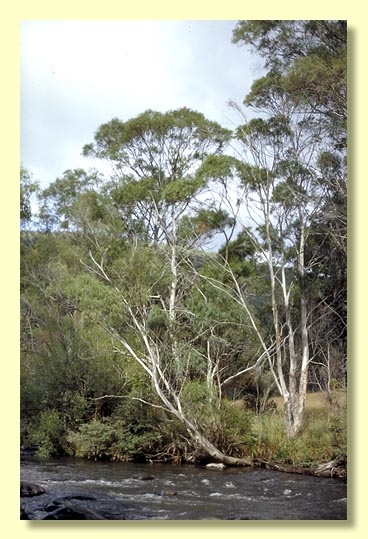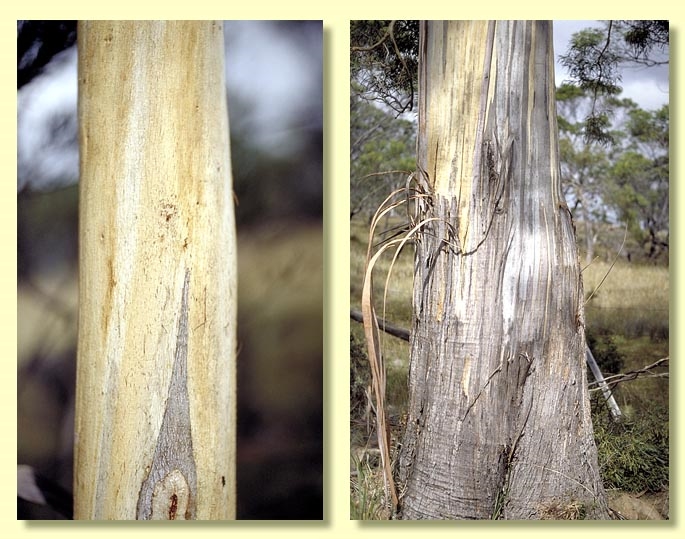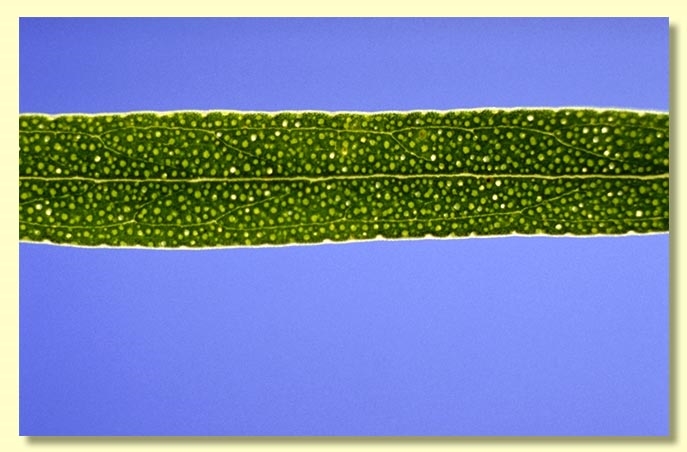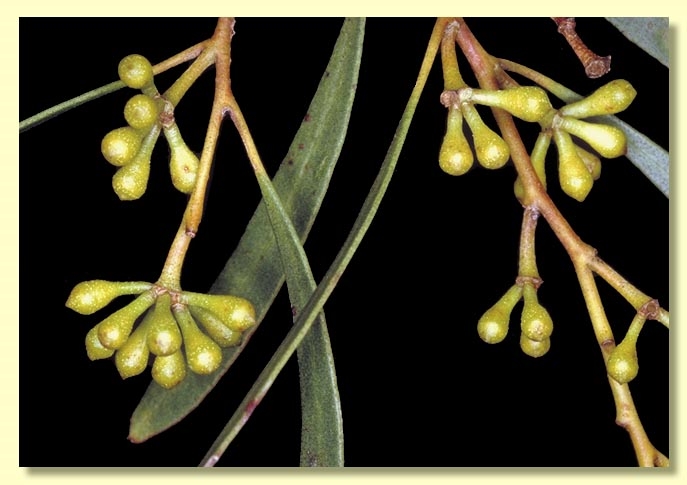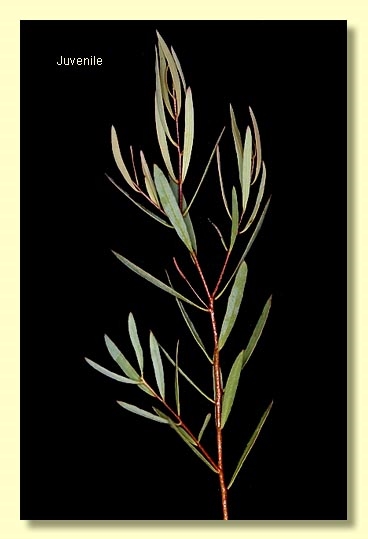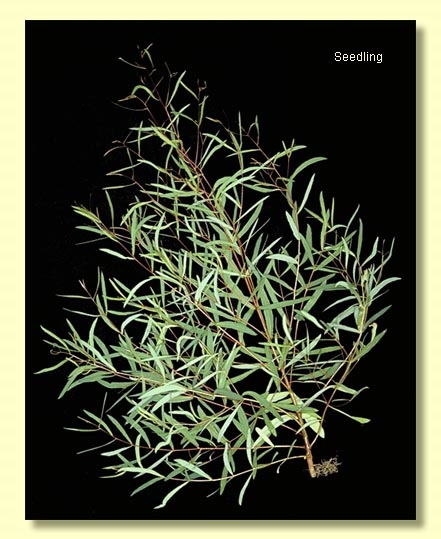Euclid - Online edition
Eucalyptus pulchella
Eucalyptus | Eucalyptus | Aromatica | Insulanae
T: New Holland, [Tas.], 1792, J. de Labillardière s.n.; holo: FI.
Eucalyptus linearis Dehnh., Cat. Pl. Horti Camaldulensis 2nd edn, 6, 20 (1832); E. amygdalina var. angustifolia F.Muell. ex Burtt Davey in L.H.Bailey, Cycl. American Hort. 2: 555 (1900). T: described from trees cultivated near Naples, Italy, the seed being from trees on Mt Wellington, Tas.
Tree to 20 m tall. Forming a lignotuber.
Bark smooth throughout on smaller trees but on larger trees rough, fibrous, grey to grey-brown for ca 1–2 m of trunk; smooth bark white, cream, yellow, pink and grey, decorticating in ribbons.
Juvenile growth (coppice or field seedlings to 50 cm): stem rounded in cross-section, warty; juvenile leaves opposite and sessile for 5 to 8 nodes then alternate, shortly petiolate, narrowly lanceolate to linear, 2–3.5 cm long, 0.2–0.4 cm wide, green.
Adult leaves alternate, petiole 0.2–1 cm long; blade linear, 3.3–12 cm long, 0.3–1 cm wide, base tapering to petiole, concolorous, glossy, usually dark green, side-veins acute or obscure, reticulation absent, intramarginal vein parallel to and just within margin, oil glands island.
Inflorescence axillary unbranched, peduncles 0.2–0.8 cm long, buds 9 to 20+ per umbel, pedicels 0.2–0.5 cm long. Mature buds obovoid to clavate, 0.3–0.6 cm long, 0.2–0.3 cm wide, green, scar absent, operculum usually rounded, stamens inflexed or irregularly flexed, anthers reniform to cordate, versatile, dorsifixed, dehiscing by confluent slits, style short or long, stigma blunt or tapered, locules usually 4, the placentae each with 2 vertical ovule rows, rarely 4 vertical rows. Flowers white.
Fruit rarely sessile, usually on pedicels to 0.3 cm long, cup-shaped to truncate-globose, 0.4–0.6 cm long, 0.5–0.7 cm wide, disc slightly raised, level or slightly descending, valves usually 4, near rim level or enclosed.
Seeds brown or reddish brown, 1–2 mm long, pyramidal or obliquely pyramidal, dorsal surface smooth, hilum terminal.
Cultivated seedlings (measured at ca node 10): cotyledons reniform; stems rounded in cross-section, warty; leaves subsessile, opposite for 5 to 8 nodes then alternate, linear, 3.5–9 cm long, 0.2–1 cm wide, base tapering, margin entire or minutely denticulate, green.
Flowering has been recorded in February, March, November and December.
A small to medium-sized tree occurring at lower elevations in hilly country of south-eastern Tasmania, north of Hobart to Bothwell and east to Swansea. Soils are often skeletal.
Eucalyptus pulchella is easily recognised by the linear adult leaves to 12 cm long and 1 cm wide, and the bark which is mostly smooth but on larger trees may be rough over the lower half of the trunk. The smooth bark is pale yellow to grey and sheds in long strips. The crown and bark characters distinguish it from other peppermint species. Juvenile leaves are narrow (to 0.4 cm wide), buds and fruit are in groups of 9 to more than 20 and densely clustered.
Eucalyptus pulchella belongs to Eucalyptus subgenus Eucalyptus section Aromatica (the peppermints) because the buds have a single operculum, anthers are reniform, ovules are in two rows, seeds are more or less pyramidal, adult leaf venation is acute or obscure and juvenile leaves are sessile and opposite for many pairs. Within this section, E. pulchella belongs to an endemic Tasmanian series of 7 species, series Insulanae, with the other species being E. risdonii, a smooth-barked tree with glaucous branchlets and a glaucous crown of opposite, sessile, juvenile leaves that are connate at the base; E. tenuiramis, a smooth-barked tree with glaucous branchlets and a crown of mixed, opposite, petiolate intermediate leaves and alternate, petiolate, adult leaves; E. nitida, a rough- or partly rough-barked tree species (rarely almost smooth), with a crown of adult, petiolate, lanceolate, green leaves; E. amygdalina a rough-barked tree of drier sites and with leaves narrower than E. nitida; and E. coccifera, a smooth-barked species of cold, high areas, with glaucous branchlets, elliptical to cordate (non-connate) juvenile leaves, a crown of elliptical to lanceolate adult leaves and warty buds in clusters of three, seven or nine (the other species have buds in clusters of nine or more). The 7th species in series Insulanae is the more recently described E. nebulosa , a small smooth-barked tree with grey-blue crown restricted to serpentine geology on ridges north-west of Rosebery; it has narrowly elliptical adult leaves in the crown and sessile short broad elliptical juvenile leaves on coppice growth.
The only other peppermint species found in Tasmania is the more distantly related, common mainland species, E. radiata subsp. radiata, a rough-barked, tall, forest tree restricted, in Tasmania, to the Lemonthyne area. It has a narrow-leaved crown of adult leaves, whilst the lanceolate juvenile leaves have numerous oil glands.

